The exhibition «Memory speaks. The road through the war»
67 photo with description26.01.2020 11:16
26.01.2020 11:16
Andrey Panevin

In St. Petersburg, in the port of Sevkabel, the exhibition «Memory speaks. The road through the war», created by the team of Dmitry Poshtarenko "Nevsky Battle".
In seven rooms there are separate episodes of the war, as they were seen by the protagonist named Nikolai and his friends.
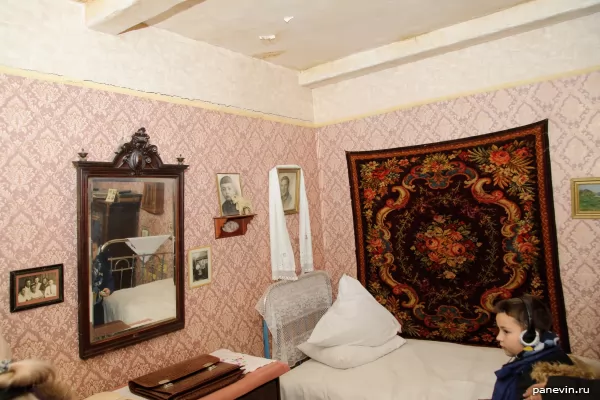
The village house, the war has already begun, but so far peace reigns here.
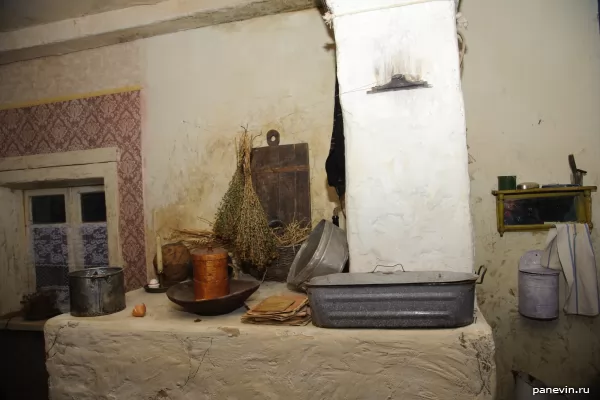
Village stove.
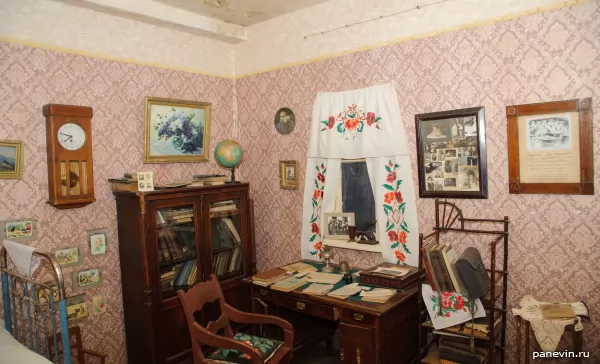
On June 22, Nikolai learns that the war has begun, without waiting for his wife and brothers to return from the fields, he hurriedly gathers and leaves a note that he has gone to the front and plans to return in August. No one then could have imagined that the war would go on for five years.
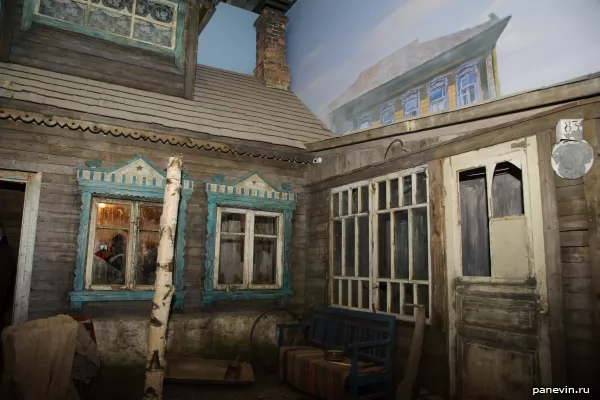
Country house.

Refugees with simple belongings leave their homes.
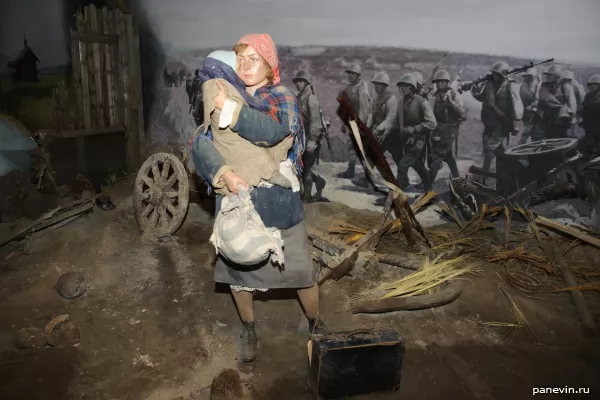
The young mother asks the retreating fighters to share at least a bit of bread for the child.
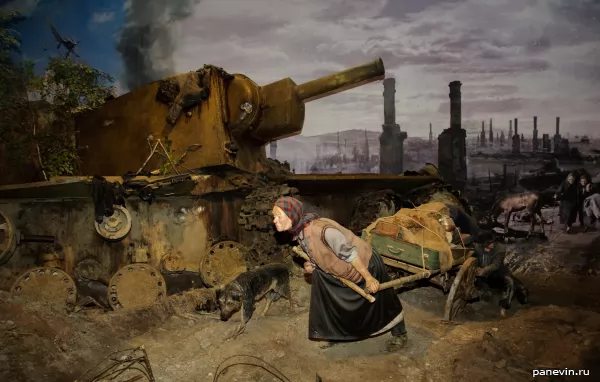
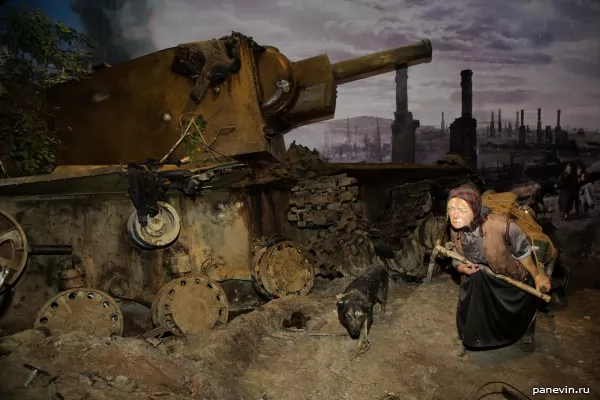
The wrecked KV tank, destroyed by an aerial bomb, in the background is a German diving bomber Ju-87 “Stuka”.
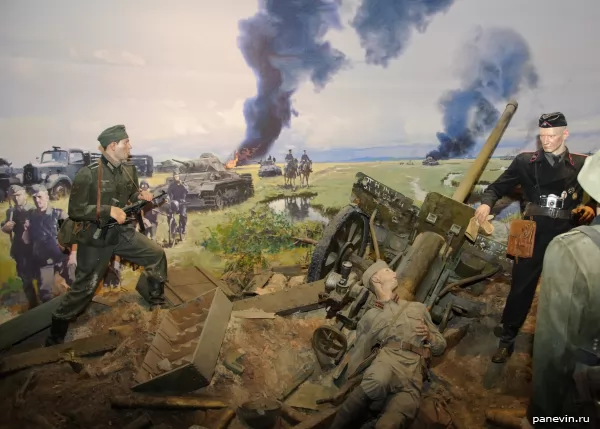
After the war, Nicholas learned how the red army fought for his village. From the calculations of the guns, only one remained alive, he gave his things to the departing remaining infantrymen with the words: “Take it, it will no longer be useful to me.” So miraculously preserved pot with a scratched name: Nicholas. Namesake. The calculation of the guns is three fighters. Imagine the surprise of the German tankers when they learned that only one man had fought against them. The Germans buried the hero with honors, and in the course of the battle for Smolensk such an incident really happened!
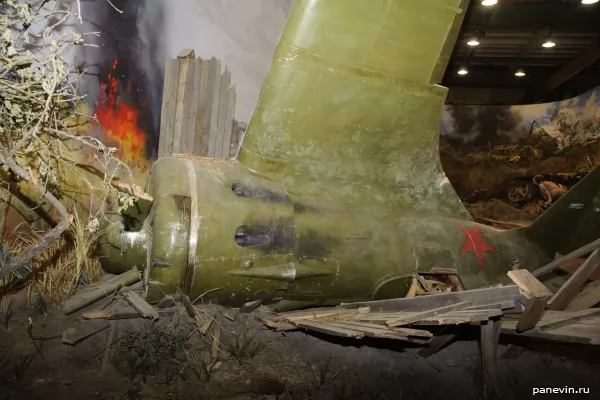
The downed fighter I-16, "Ishak." Although in the early days the Germans managed to burn part of the aircraft at airfields, and most of the Red Army fighters were considered obsolete, but the Stalinist falcons shot down 44 enemy aircraft on the very first day of the war, 7 of which were rams. So the Luftwaffe first learned what an air ram is, as the last measure, when the ammunition was already over.
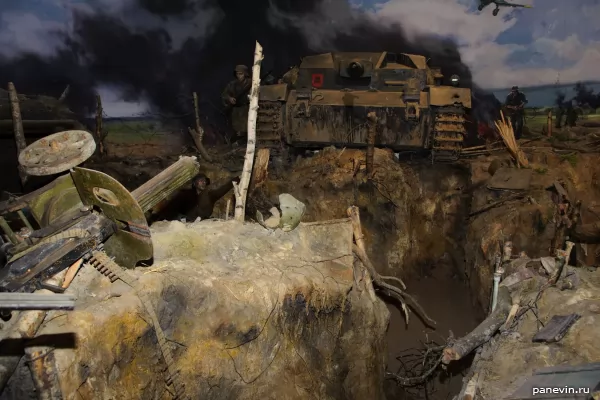
Luga border. Then the Nazis were detained for 16 weeks. The plan of lightning war began to crack at the seams.
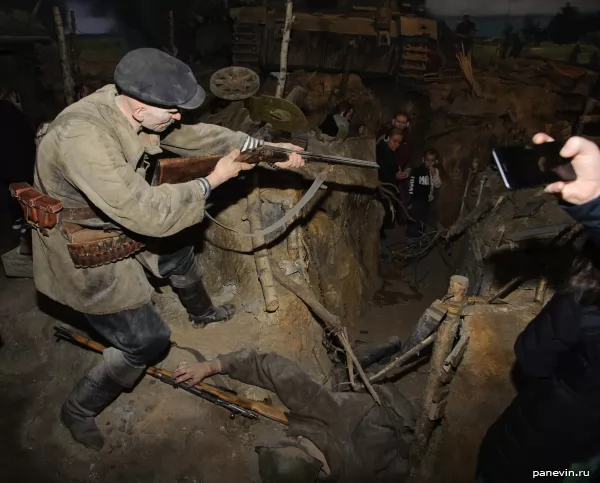
Militia fighter with a hunting shotgun. Leningrad alone put under arms a whole army of militias. The hero in the foreground - passed the First World War and Civil. He taught militias hand-to-hand combat techniques.
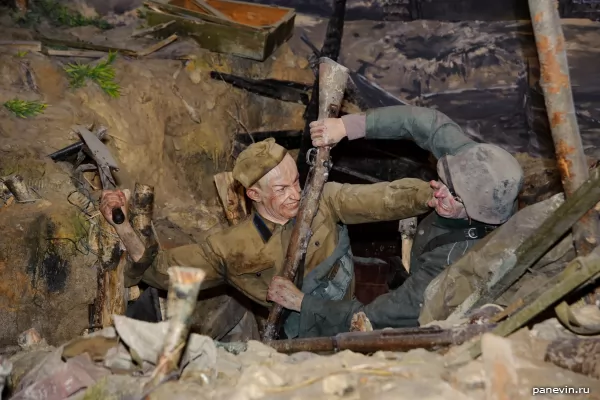
Melee.
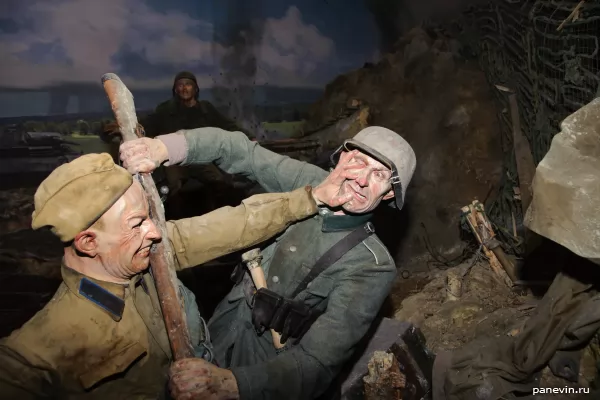

Yes, the Wehrmacht did not expect such resistance.

Different objects are scattered along the layout, a coil of signalmen, and on the left - the back of a regular bed, as part of the fortification.
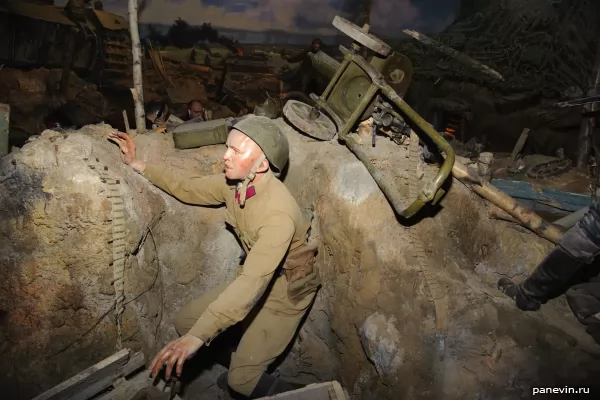
The machine gun is broken, the German Stug runs into the trench, but the formidable car has a weak spot - a gasoline engine. The fighter reaches for the Molotov cocktail.

"Molotov cocktail".
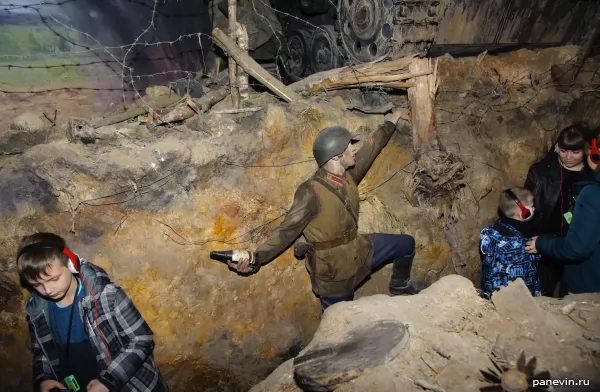
Walking around the exhibition between the fighters, visitors become like participants in the events.
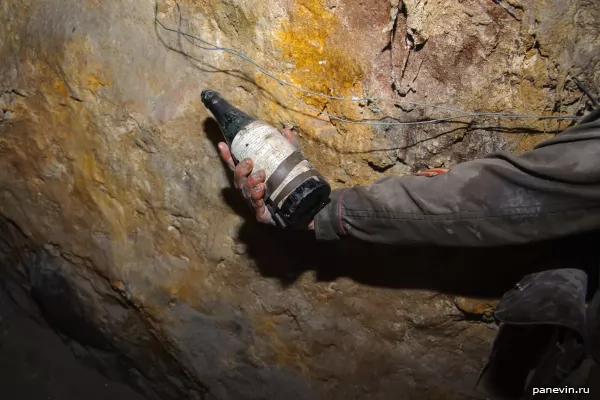
At the beginning of the war, many civilian factories curtailed production and began to produce products for the needs of the front, including the Molotov Cocktails. Pioneers in all cities collected bottles for such production.
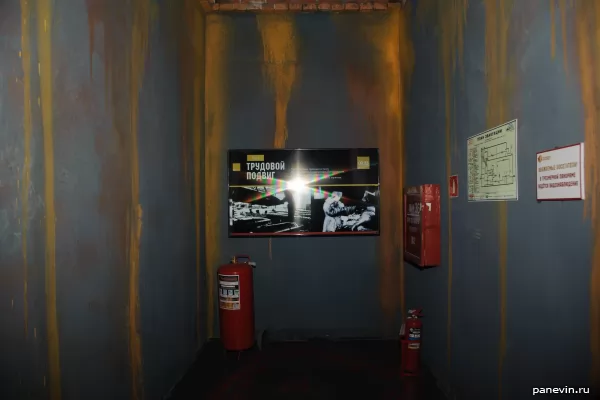
Screens with newsreels were installed in the aisles between the halls, in the next room there is a story about the labor feat of the Tula, as a collective image of all the workers of the country.
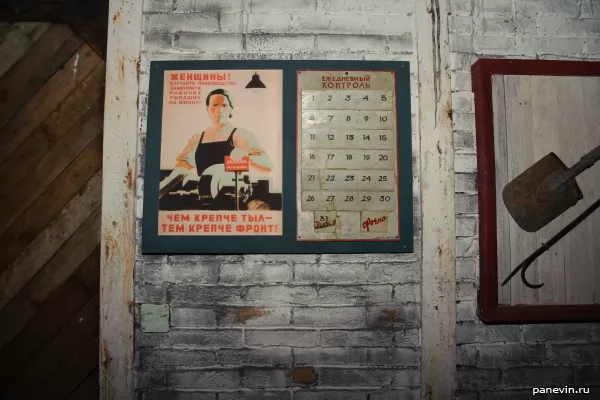
Poster: "Women! The tighter the rear, the tighter the front! ”

Factories worked around the clock in several shifts, workers slept right in the shops.
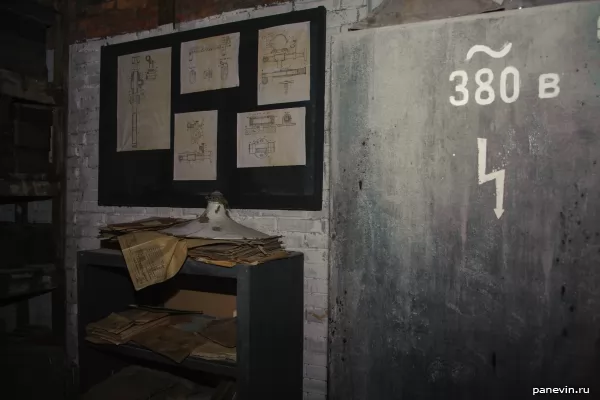
Drawings of the Mosin rifle and individual parts of tanks.
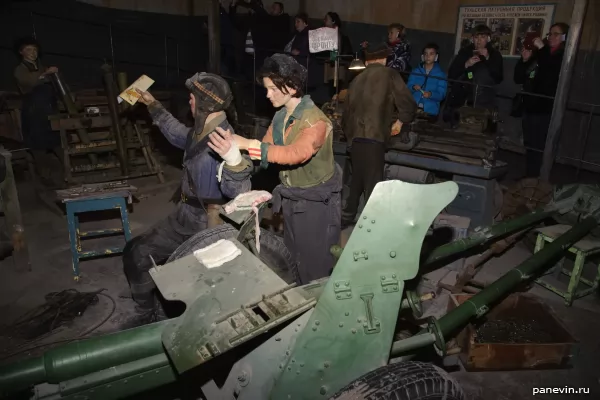
The tankman gives the factory workers a chocolate bar, with the words that "this is a gift from the Fritz."

Sign: “Tula does not sleep, Tula works”
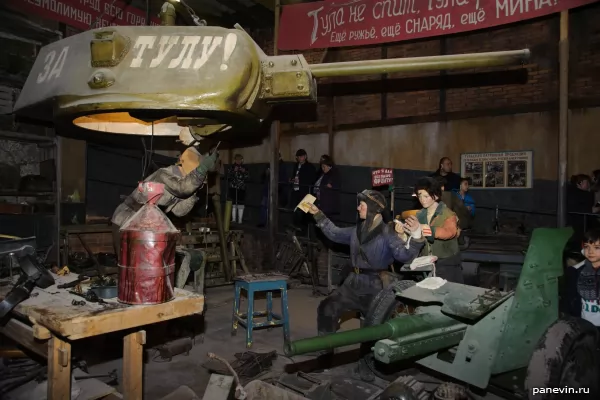
Tank assembly shop.
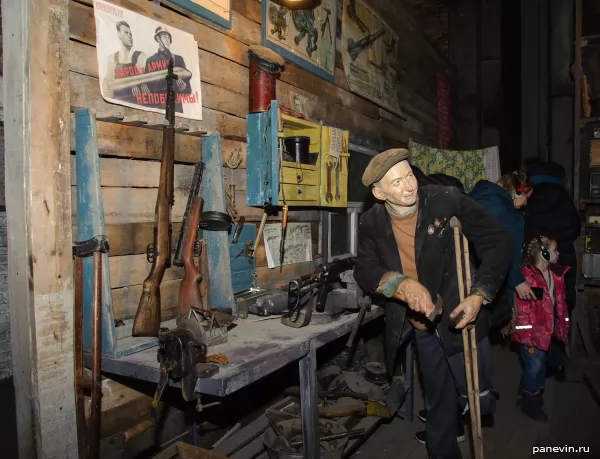
Volodya. “- A worker at the exposition,” Dmitry Poshtarenko explains. “His smile is very kind. I was wondering how to use this smile ... And so I found it. Moreover, they put him on a bamboo crutch, it’s all the more tragic, combined with that smile ... And the whole Tula turned out to be good, but I wanted it to be different from the rest of the panorama ... ”A worker who lost his leg managed to grind more details than other healthy ones. The order of the "Red Star" is noteworthy - this is simply not given.
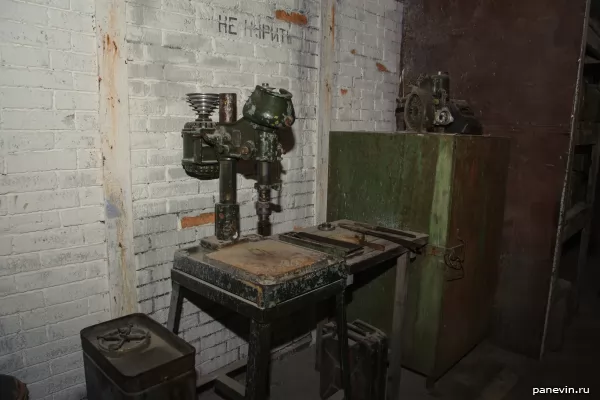
Drilling machine.
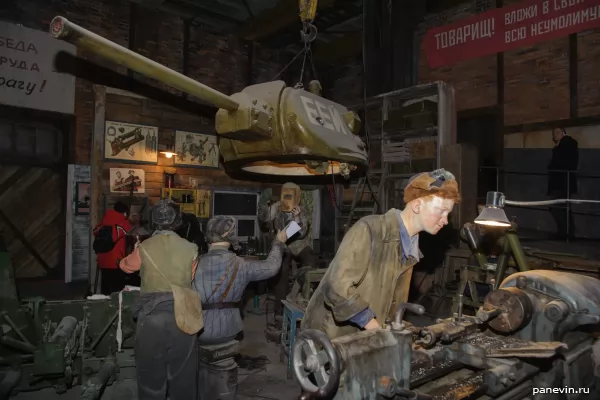
The men who went to the front in the factories were replaced by young men and women.
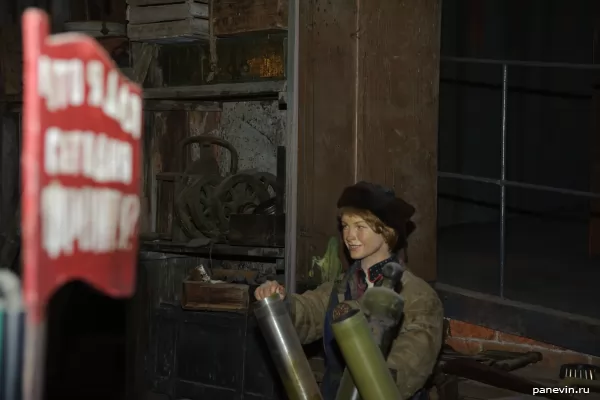
Girl with a mortar blank.
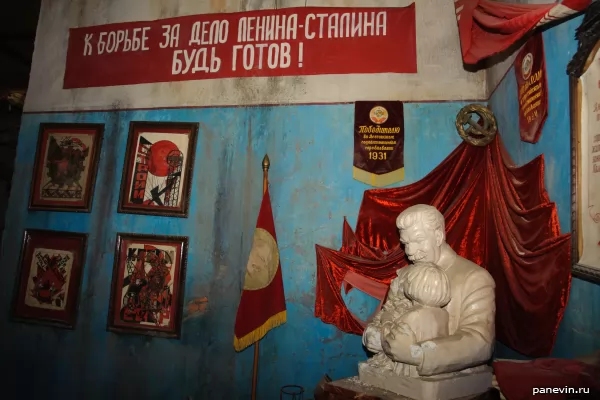
Stalingrad, the red corner of the school.
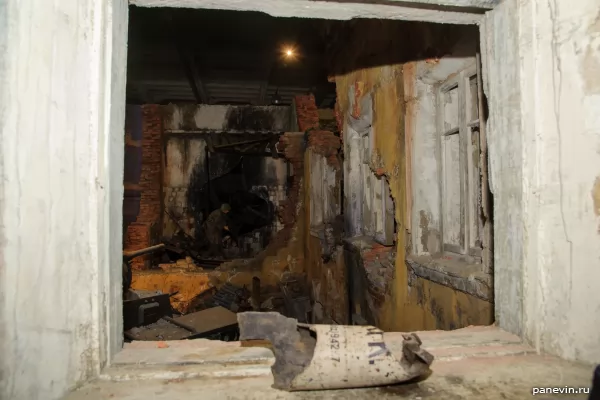
A fragment of a German mine on a windowsill.
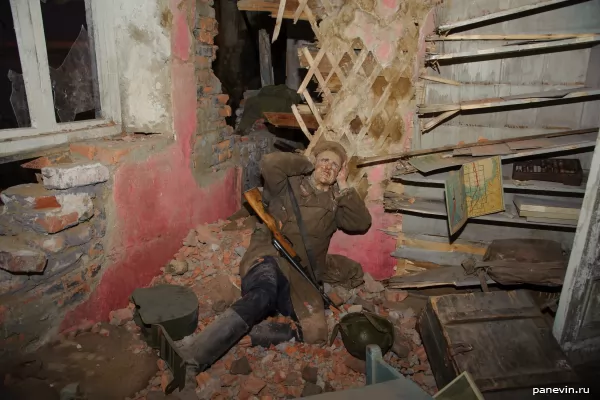
The fighter was stunned by the explosion. For the only building that survived several blocks, for this school, there is a fierce battle. He who controls the school controls the whole area.
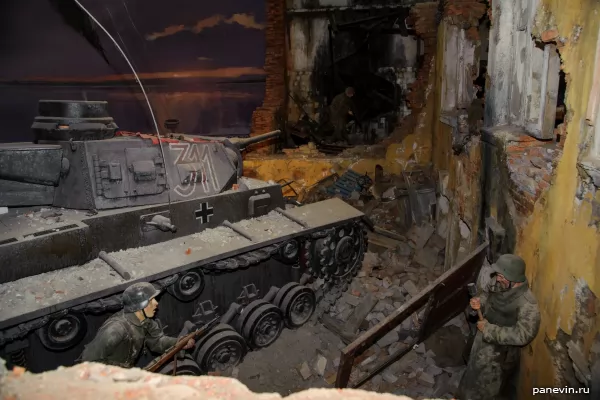
Therefore, the Germans stormed the school constantly, trying to break through to the Volga.
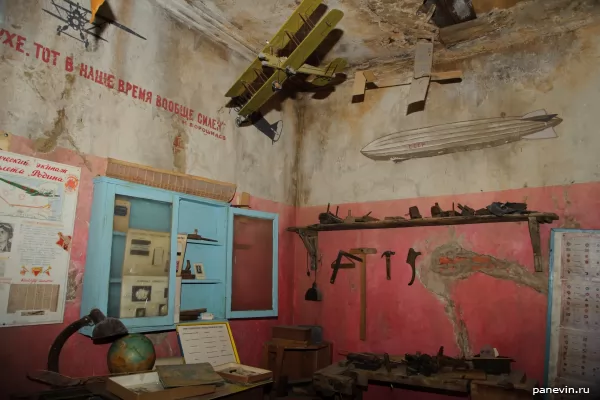
Cabinet of labor.
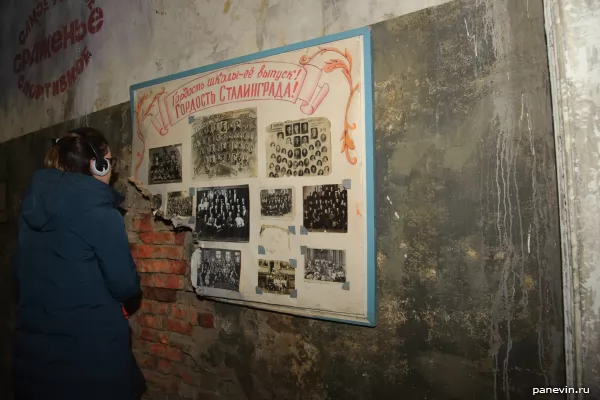
Hall of Fame.
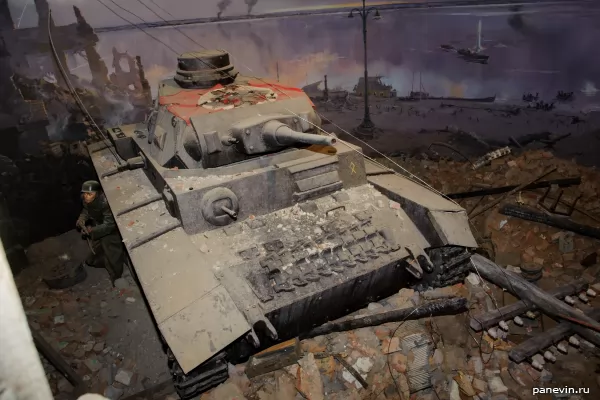
In the distance - crossing the Volga, reinforcements are being transferred to the city and the wounded are evacuated.
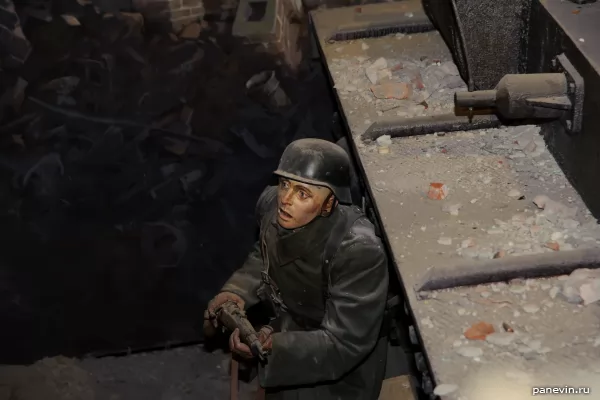
Yes, this is not France, not Montmartre.
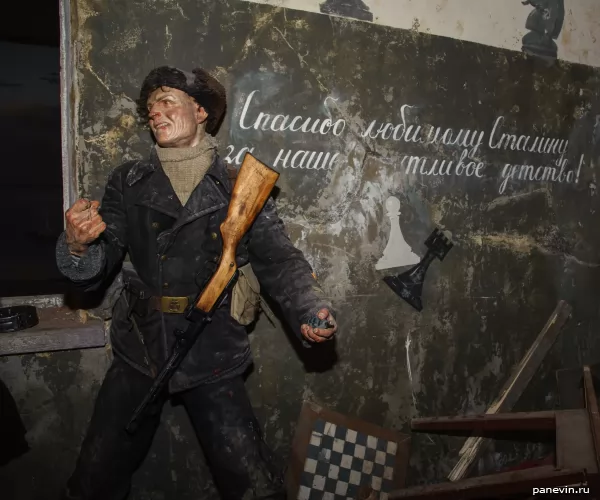
Sailor prepares to throw a lemon in the window.
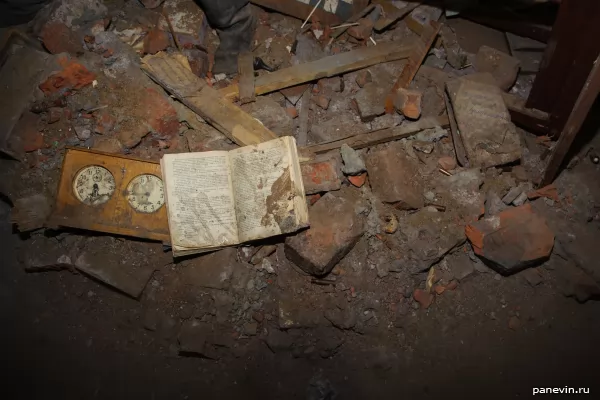
A book on the wreckage of bricks.
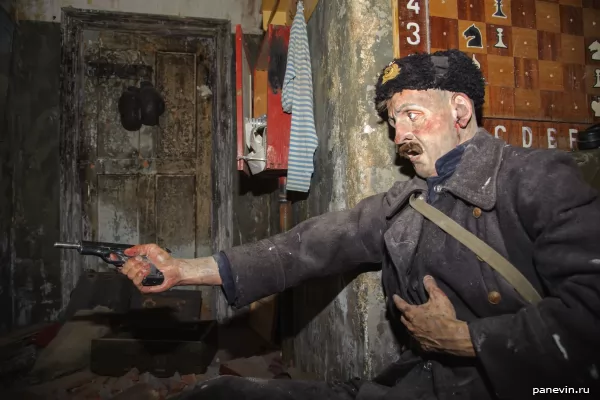
The last cartridge ...
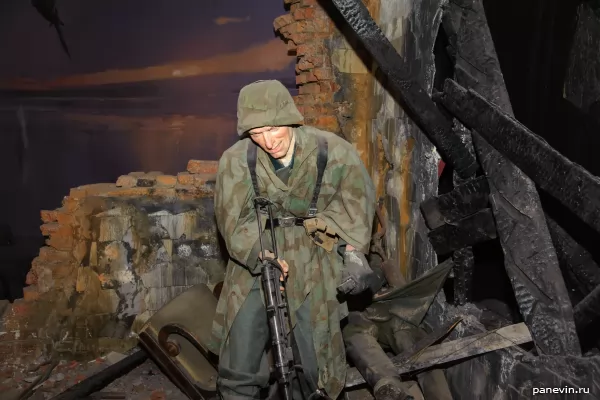
The SS man reloads the machine.
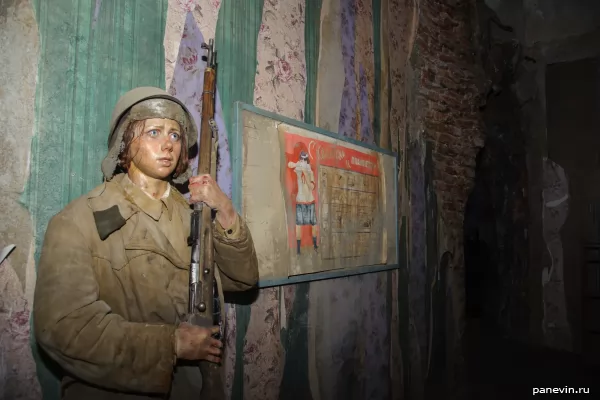
A girl with a rifle, Alena - by the name of the artist who painted her. Andrei Kolesnikov: “A girl stands tight against a wall with a mirror, and around the corner her commander with a gun is wounded, and a German with a machine gun is already entering the room, and the commander apparently has no bullets, the girl has to turn around and shoot, and her face is fear and determination ... This, if you look closely, is a whole movie episode, and we don’t even know if she turned around, whether she could find the strength in herself, because it would seem to be shooting for the first time. But I’m sure that I will turn around and take my step. ”
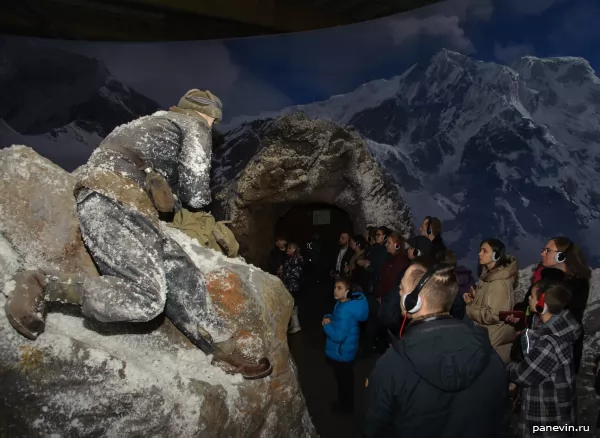
The battle for the Caucasus.
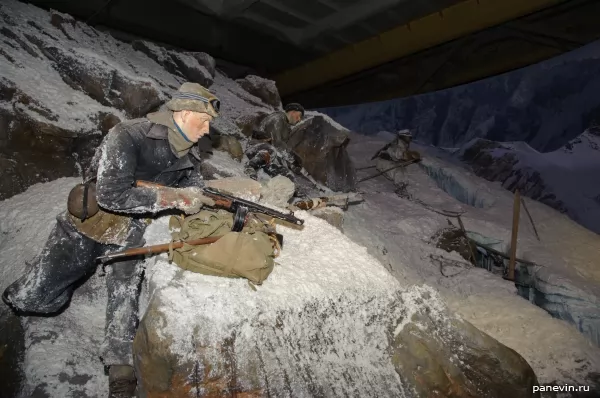
Mountain arrows.
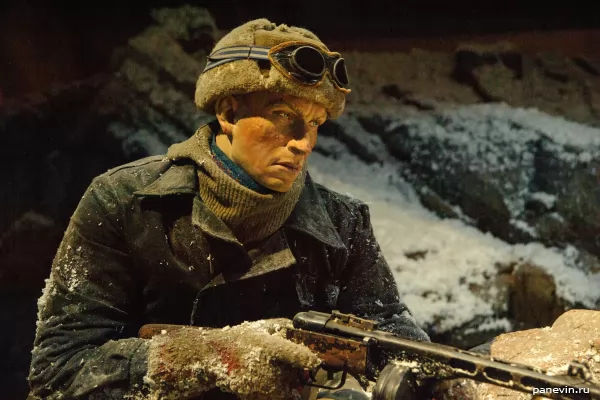
An outstanding climber and athlete is Mikhail Mikhailovich Bobrov. It was he, with two climbers, who masked the high-altitude dominants in Leningrad, now he is entrusted with training the Soviet mountain riflemen.
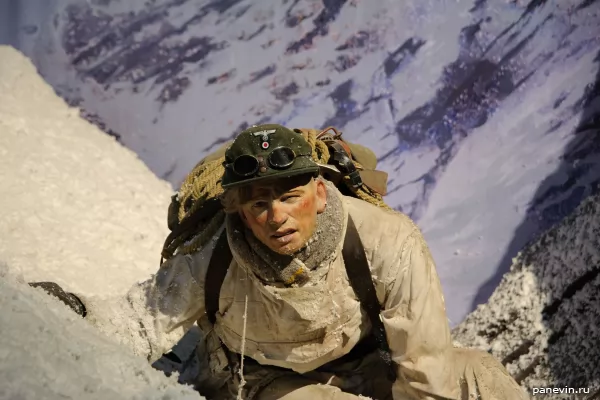
This episode captures the battle during which all the soldiers of the detachment of the elite German division Edelweiss were killed, and the commander was captured. Bobrov scored our mountain shooters from the Svans, and these highlanders feel when and where the avalanche will go and where the enemy is.

Crossing the Dnieper. The enemy artillery smashes rafts and boats of ferrying soldiers of the Red Army into chips.
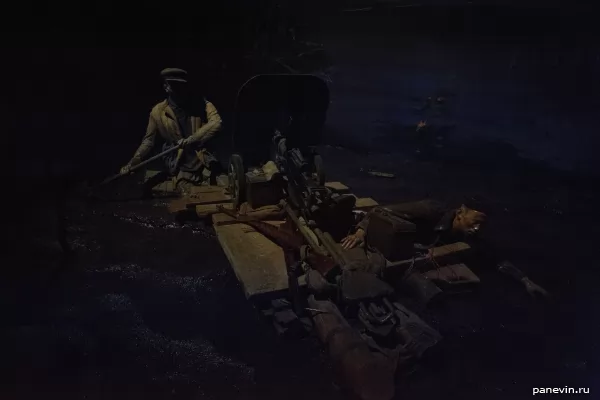
The story is told, according to which Nikolai asks the Uzbek how he managed to swim before the main character? - But I don’t know how to swim, so the crab is struggling. I didn’t want to die so ingloriously, not in battle, but to drown ...
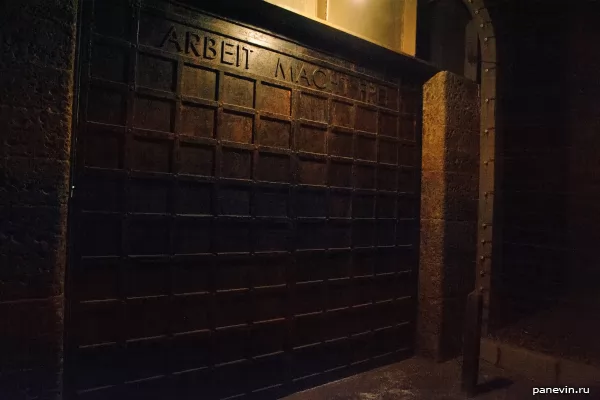
Auschwitz (Auschwitz).

The Red Army freed 3,000 survivors of the Auschwitz death camp. The Germans were in a hurry to destroy everyone, they did not have time. The stoves could not cope.
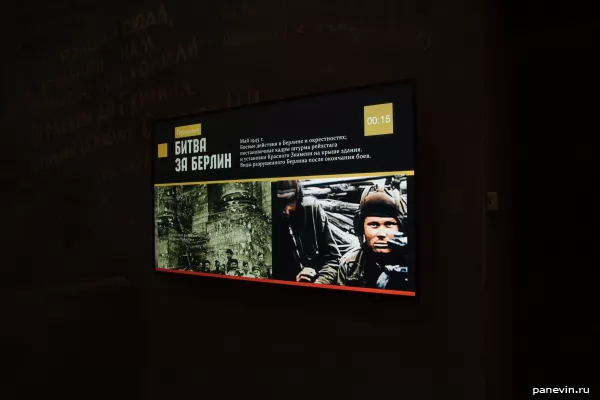
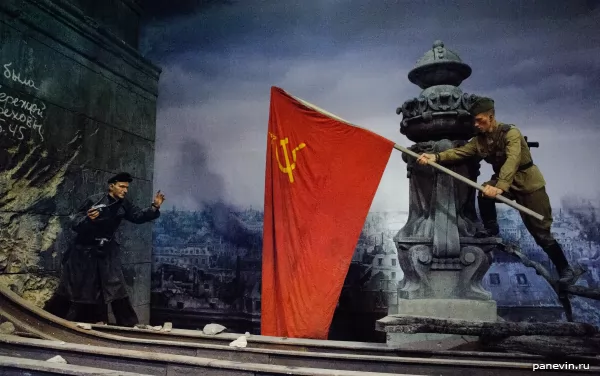
The military commander Eugene Chaldey asks the fighter to pose for a picture that will fly around all the newspapers in the world. Reichstag taken!
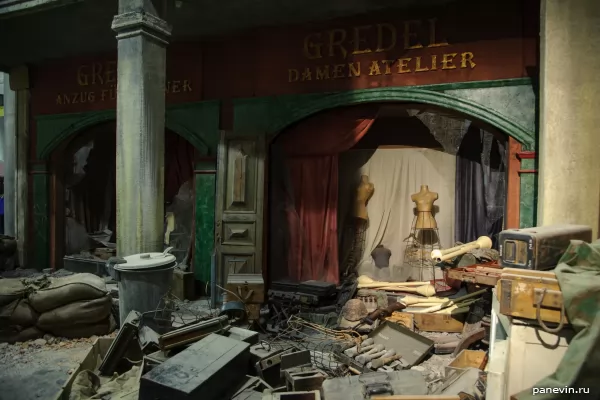
Street of Berlin, broken shop windows. Ammunition boxes, on the right is the Faustpatron.
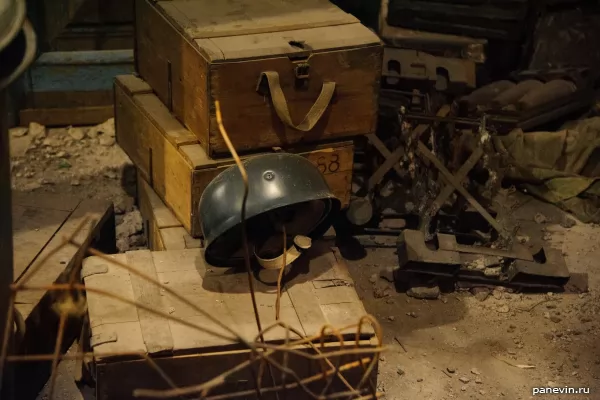
Goering's parachutist helmet is an SS elite.
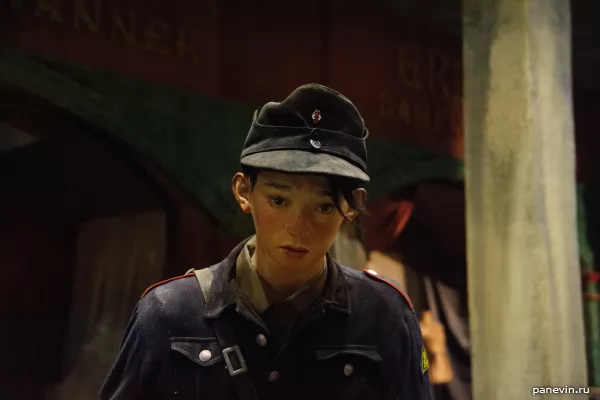
Hitler Youth.
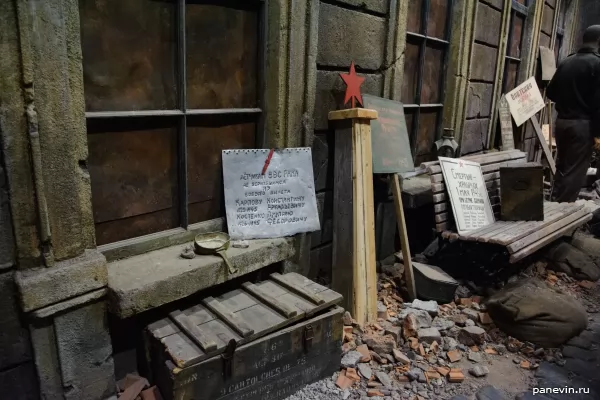
Now we need to bury everyone ... Half a million Soviet soldiers entered Berlin. Killed 75 thousand. The Red Army paid a huge price, German propaganda trumpeted that the Russians would level the city and kill everyone. The Germans fought especially fiercely.

Russians draw tablets on the graves of dead friends.

The Allies (British) at first do not understand what the Russians are doing ...
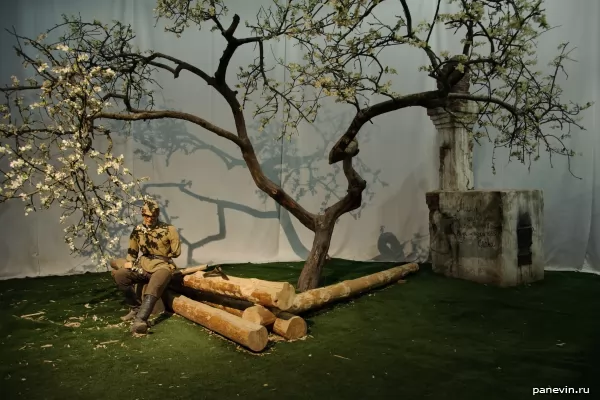
The hero of the story knows that his village was burned and all relatives were killed. Therefore, he remains in Germany an overdue. Mine, he is blown up by a mine and loses his hand. Returning to the village, he discovers a miraculously surviving apple tree. A year later, he learns that his son is alive! Still, they managed to evacuate the children, that the director of the boarding school found out that the hero was alive and personally wrote a letter.
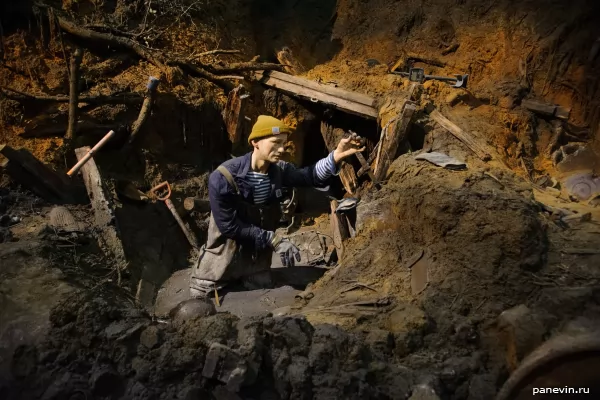
The last room tells about the work of search units. "The war is not over until the last soldier is buried."

The Soviet government ignored the search movement, enthusiasts engaged in it for a long time. They were recognized only in the 80s, but the Union collapsed and the "saints of the 90s" came, the search engines again lost the support of the state and became left to their own devices.
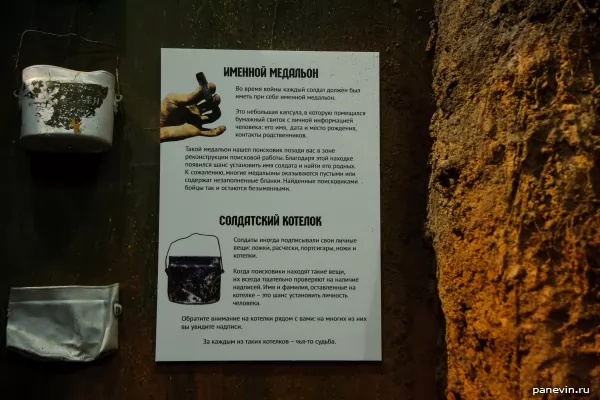
Not all soldiers had medallions, therefore it is possible to identify a soldier raised from the ground only by scratched name on a bowler or spoon.
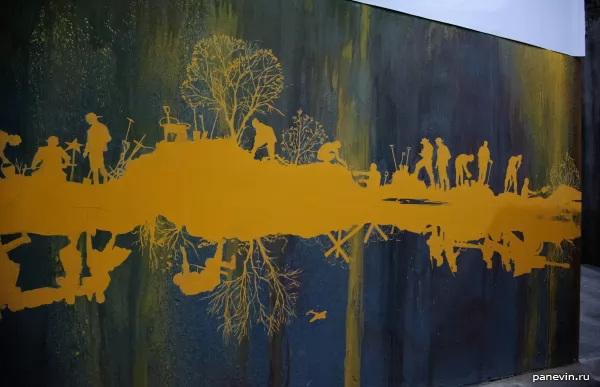
Currently, the private initiative of "diggers" is prohibited, search engine clubs operate under the supervision and support of the state and the Ministry of Defense.

The installation, repeating the famous German panorama, shot from the Pulkovo heights, on which all the high-rise dominants of the city were signed, as landmarks for artillery.
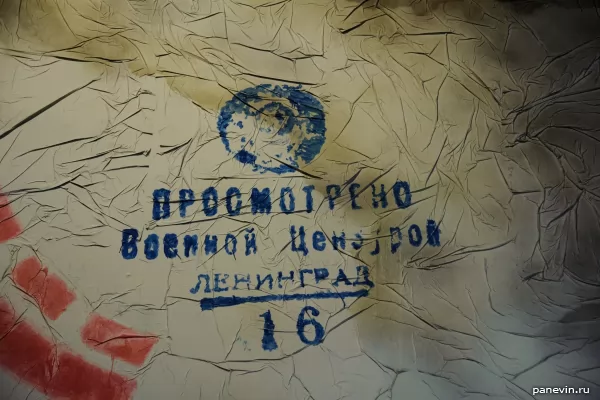
Panorama address “Memory says. The road through the war ": St. Petersburg, Sevkabel, Leather line, 40.
I advise you to buy tickets in advance on the Nevsky Batalist team website, save half an hour. Ticket - 200 p. , preferential - 100 p. The panorama area is impressive - 2 thousand square meters. m. It will work until June 6, 2020.

The village house, the war has already begun, but so far peace reigns here.

Village stove.

On June 22, Nikolai learns that the war has begun, without waiting for his wife and brothers to return from the fields, he hurriedly gathers and leaves a note that he has gone to the front and plans to return in August. No one then could have imagined that the war would go on for five years.

Country house.

Refugees with simple belongings leave their homes.

The young mother asks the retreating fighters to share at least a bit of bread for the child.


The wrecked KV tank, destroyed by an aerial bomb, in the background is a German diving bomber Ju-87 “Stuka”.

After the war, Nicholas learned how the red army fought for his village. From the calculations of the guns, only one remained alive, he gave his things to the departing remaining infantrymen with the words: “Take it, it will no longer be useful to me.” So miraculously preserved pot with a scratched name: Nicholas. Namesake. The calculation of the guns is three fighters. Imagine the surprise of the German tankers when they learned that only one man had fought against them. The Germans buried the hero with honors, and in the course of the battle for Smolensk such an incident really happened!

The downed fighter I-16, "Ishak." Although in the early days the Germans managed to burn part of the aircraft at airfields, and most of the Red Army fighters were considered obsolete, but the Stalinist falcons shot down 44 enemy aircraft on the very first day of the war, 7 of which were rams. So the Luftwaffe first learned what an air ram is, as the last measure, when the ammunition was already over.

Luga border. Then the Nazis were detained for 16 weeks. The plan of lightning war began to crack at the seams.

Militia fighter with a hunting shotgun. Leningrad alone put under arms a whole army of militias. The hero in the foreground - passed the First World War and Civil. He taught militias hand-to-hand combat techniques.

Melee.


Yes, the Wehrmacht did not expect such resistance.

Different objects are scattered along the layout, a coil of signalmen, and on the left - the back of a regular bed, as part of the fortification.

The machine gun is broken, the German Stug runs into the trench, but the formidable car has a weak spot - a gasoline engine. The fighter reaches for the Molotov cocktail.

"Molotov cocktail".

Walking around the exhibition between the fighters, visitors become like participants in the events.

At the beginning of the war, many civilian factories curtailed production and began to produce products for the needs of the front, including the Molotov Cocktails. Pioneers in all cities collected bottles for such production.

Screens with newsreels were installed in the aisles between the halls, in the next room there is a story about the labor feat of the Tula, as a collective image of all the workers of the country.

Poster: "Women! The tighter the rear, the tighter the front! ”

Factories worked around the clock in several shifts, workers slept right in the shops.

Drawings of the Mosin rifle and individual parts of tanks.

The tankman gives the factory workers a chocolate bar, with the words that "this is a gift from the Fritz."

Sign: “Tula does not sleep, Tula works”

Tank assembly shop.

Volodya. “- A worker at the exposition,” Dmitry Poshtarenko explains. “His smile is very kind. I was wondering how to use this smile ... And so I found it. Moreover, they put him on a bamboo crutch, it’s all the more tragic, combined with that smile ... And the whole Tula turned out to be good, but I wanted it to be different from the rest of the panorama ... ”A worker who lost his leg managed to grind more details than other healthy ones. The order of the "Red Star" is noteworthy - this is simply not given.

Drilling machine.

The men who went to the front in the factories were replaced by young men and women.

Girl with a mortar blank.

Stalingrad, the red corner of the school.

A fragment of a German mine on a windowsill.

The fighter was stunned by the explosion. For the only building that survived several blocks, for this school, there is a fierce battle. He who controls the school controls the whole area.

Therefore, the Germans stormed the school constantly, trying to break through to the Volga.

Cabinet of labor.

Hall of Fame.

In the distance - crossing the Volga, reinforcements are being transferred to the city and the wounded are evacuated.

Yes, this is not France, not Montmartre.

Sailor prepares to throw a lemon in the window.

A book on the wreckage of bricks.

The last cartridge ...

The SS man reloads the machine.

A girl with a rifle, Alena - by the name of the artist who painted her. Andrei Kolesnikov: “A girl stands tight against a wall with a mirror, and around the corner her commander with a gun is wounded, and a German with a machine gun is already entering the room, and the commander apparently has no bullets, the girl has to turn around and shoot, and her face is fear and determination ... This, if you look closely, is a whole movie episode, and we don’t even know if she turned around, whether she could find the strength in herself, because it would seem to be shooting for the first time. But I’m sure that I will turn around and take my step. ”

The battle for the Caucasus.

Mountain arrows.

An outstanding climber and athlete is Mikhail Mikhailovich Bobrov. It was he, with two climbers, who masked the high-altitude dominants in Leningrad, now he is entrusted with training the Soviet mountain riflemen.

This episode captures the battle during which all the soldiers of the detachment of the elite German division Edelweiss were killed, and the commander was captured. Bobrov scored our mountain shooters from the Svans, and these highlanders feel when and where the avalanche will go and where the enemy is.

Crossing the Dnieper. The enemy artillery smashes rafts and boats of ferrying soldiers of the Red Army into chips.

The story is told, according to which Nikolai asks the Uzbek how he managed to swim before the main character? - But I don’t know how to swim, so the crab is struggling. I didn’t want to die so ingloriously, not in battle, but to drown ...

Auschwitz (Auschwitz).

The Red Army freed 3,000 survivors of the Auschwitz death camp. The Germans were in a hurry to destroy everyone, they did not have time. The stoves could not cope.


The military commander Eugene Chaldey asks the fighter to pose for a picture that will fly around all the newspapers in the world. Reichstag taken!

Street of Berlin, broken shop windows. Ammunition boxes, on the right is the Faustpatron.

Goering's parachutist helmet is an SS elite.

Hitler Youth.

Now we need to bury everyone ... Half a million Soviet soldiers entered Berlin. Killed 75 thousand. The Red Army paid a huge price, German propaganda trumpeted that the Russians would level the city and kill everyone. The Germans fought especially fiercely.

Russians draw tablets on the graves of dead friends.

The Allies (British) at first do not understand what the Russians are doing ...

The hero of the story knows that his village was burned and all relatives were killed. Therefore, he remains in Germany an overdue. Mine, he is blown up by a mine and loses his hand. Returning to the village, he discovers a miraculously surviving apple tree. A year later, he learns that his son is alive! Still, they managed to evacuate the children, that the director of the boarding school found out that the hero was alive and personally wrote a letter.

The last room tells about the work of search units. "The war is not over until the last soldier is buried."

The Soviet government ignored the search movement, enthusiasts engaged in it for a long time. They were recognized only in the 80s, but the Union collapsed and the "saints of the 90s" came, the search engines again lost the support of the state and became left to their own devices.

Not all soldiers had medallions, therefore it is possible to identify a soldier raised from the ground only by scratched name on a bowler or spoon.

Currently, the private initiative of "diggers" is prohibited, search engine clubs operate under the supervision and support of the state and the Ministry of Defense.

The installation, repeating the famous German panorama, shot from the Pulkovo heights, on which all the high-rise dominants of the city were signed, as landmarks for artillery.

Panorama address “Memory says. The road through the war ": St. Petersburg, Sevkabel, Leather line, 40.
I advise you to buy tickets in advance on the Nevsky Batalist team website, save half an hour. Ticket - 200 p. , preferential - 100 p. The panorama area is impressive - 2 thousand square meters. m. It will work until June 6, 2020.
Share:
Themes: museums 22 Nevsky battle 3 photos 417 Second World War 8 St.-Petersburg 119
Ticket sales through JetRadar.com service without commissions and markups.
← Blog
vistavka_pamyat_govorit_doroga_cherez
blog







